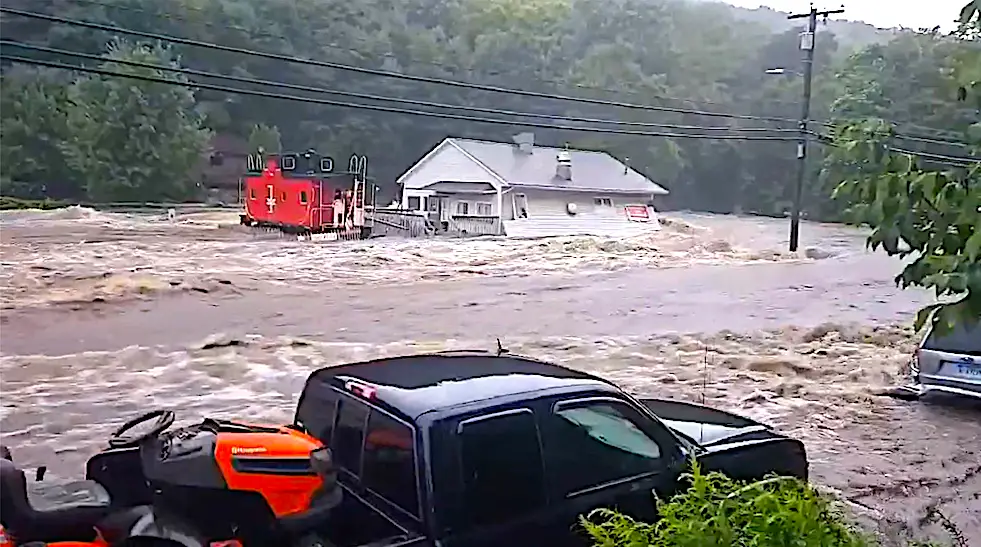(CNN) — The governor of Connecticut declared a state of emergency after historic flooding left two dead and prompted hundreds of evacuations, he said in an August 19 news conference.
“This declaration can help expedite some of the resources needed for us to respond, including potential federal support,” Gov. Ned Lamont wrote in a post on X. “Hundreds of evacuations and swift water rescues were necessary to remove people from dangerous areas and shelters were opened.”
The two people were found dead in the town of Oxford, Fire Chief Scott Pelletier told CNN. The town is about 15 miles northwest of New Haven.
One female victim was swept away in floodwaters while firefighters were trying to perform a rescue August 18, Pelletier said at the August 19 news conference. The other was in a vehicle and was “clinging” to a sign as firefighters in high-wheel vehicles tried to reach her. The racing water was “too much” and swept her away, he said. Both victims were Oxford residents, according to Connecticut State Police.

Brenda Bergeron, deputy commissioner at the state Division of Emergency Management and Homeland Security, described how the rain produced “historic, unprecedented flooding.”
“We are talking about rainfall in some areas in the 1,000-year level,” Bergeron said, meaning it was so intense that on average it should only happen every 1,000 years.
A flash flood emergency issued August 18 was later downgraded to a flood warning in the cities of Waterbury, Danbury and the town of Fairfield.
First responders rescued 19 people and a dog Sunday night from an Oxford restaurant and nearby apartment, Jeremy Rodorigo, Beacon Falls emergency management director, told CNN.
The Brookside Inn was surrounded by rushing water with about 18 people inside, Rodorigo said.
“We were concerned that the restaurant was compromised and was going to get washed away,” he said. “We had a very short window of time to get over there, set up a ladder truck and extend our ladder 100 feet to rescue them.”
Responders also rescued an older woman and her dog from the apartment connected to the property, Rodorigo said. No one was injured, he added.
“We will continue helping towns with any resources they need to immediately respond and keep the public safe,” Lamont said.
Southwestern Connecticut saw 6 to 10 inches of rainfall in about six to nine hours on August 18, David Stark of the National Weather Service in New York told CNN. Monroe, Connecticut, received 9.98 inches of rain – a one in 200-year event for the city.
“Emergency management is continuing to report ongoing water rescues, several mudslides, numerous washed out roadways and bridges as well as swollen rivers taking place from Central Fairfield County into Northern New Haven County. In addition, emergency management official are assessing the integrity of several dams in the area,” the weather service said.
Oxford, where the two women were found dead, has been particularly hard-hit by the rain and flooding.
The town “got sucker-punched yesterday and then taken out at the knees,” state Sen. Eric Berthel said at the Monday news conference.
“Our infrastructure is broken, our main highway that runs through this town is broken, we have loss of life, we have a loss of businesses, we have people who have significant damages to their homes,” he said. “We will need the full strength of the local government and the state government and the federal government to fix this beautiful town and get it back running in the right direction again.”
Nearby Seymour, a town of almost 17,000, also saw “heartbreaking and gut-churning” devastation, Sen. Richard Blumenthal said at the news conference.
There was severe damage “not just to the physical infrastructure, roads, bridges” but also “to the small businesses, who have suffered damage they cannot recover,” he said.
Blumenthal noted many of the affected businesses did not have flood insurance, as flooding is relatively uncommon in the area.
The senator linked the extreme weather to climate change and highlighted the importance of making the state more resilient.
“Resilience against climate change is not just for the coast line,” he said. “Flash flooding and other disasters affect all of Connecticut. We all have a stake in planning and preparing.”
The heavy rainfall also created dangerous driving conditions in Connecticut, prompting several cities and towns – including Stamford, Danbury, Southbury and Naugatuck – to close roads.
“Multiple roads in town are flooded due to heavy rainfall. We are advising residents to stay in their homes, if at all possible,” Southbury Police said. “Crews are working around town, responding to emergencies and road closures.”
“A good number of roads in the western portion of the state are closed and are expected to remain closed for an extended period,” Lamont said in his statement.
Train service was also suspended in some areas. A mudslide near Seymore, Connecticut, resulted in suspended train service in both directions on the Metro-North Railroad Waterbury Branch.
On August 18, heavy rainfall also triggered a mudslide, leading to a gas leak near an apartment complex in Danbury, which had to be evacuated, Danbury Public Information Officer Erin Henry told CNN.
Another Danbury apartment complex on Main Street also had to be evacuated due to flooding, Henry added.
Connecticut’s emergency operations center is monitoring the situation and has deployed an urban search and rescue team to Southbury, the state’s Emergency Management and Homeland Security Department said in a post on X.
At least two state parks were closed due to flooding, according to posts on the Connecticut State Parks X account.
Meanwhile, more than 700 flights were canceled at the three major airports near New York City on August 18 as thunderstorms hit the area.
CNN Meteorologist Elisa Raffa and CNN’s Amanda Jackson, Susannah Cullinane, Zoe Sottile and Christina Zdanowicz contributed to this report.
The-CNN-Wire
™ & © 2024 Cable News Network, Inc., a Warner Bros. Discovery Company. All rights reserved.




















